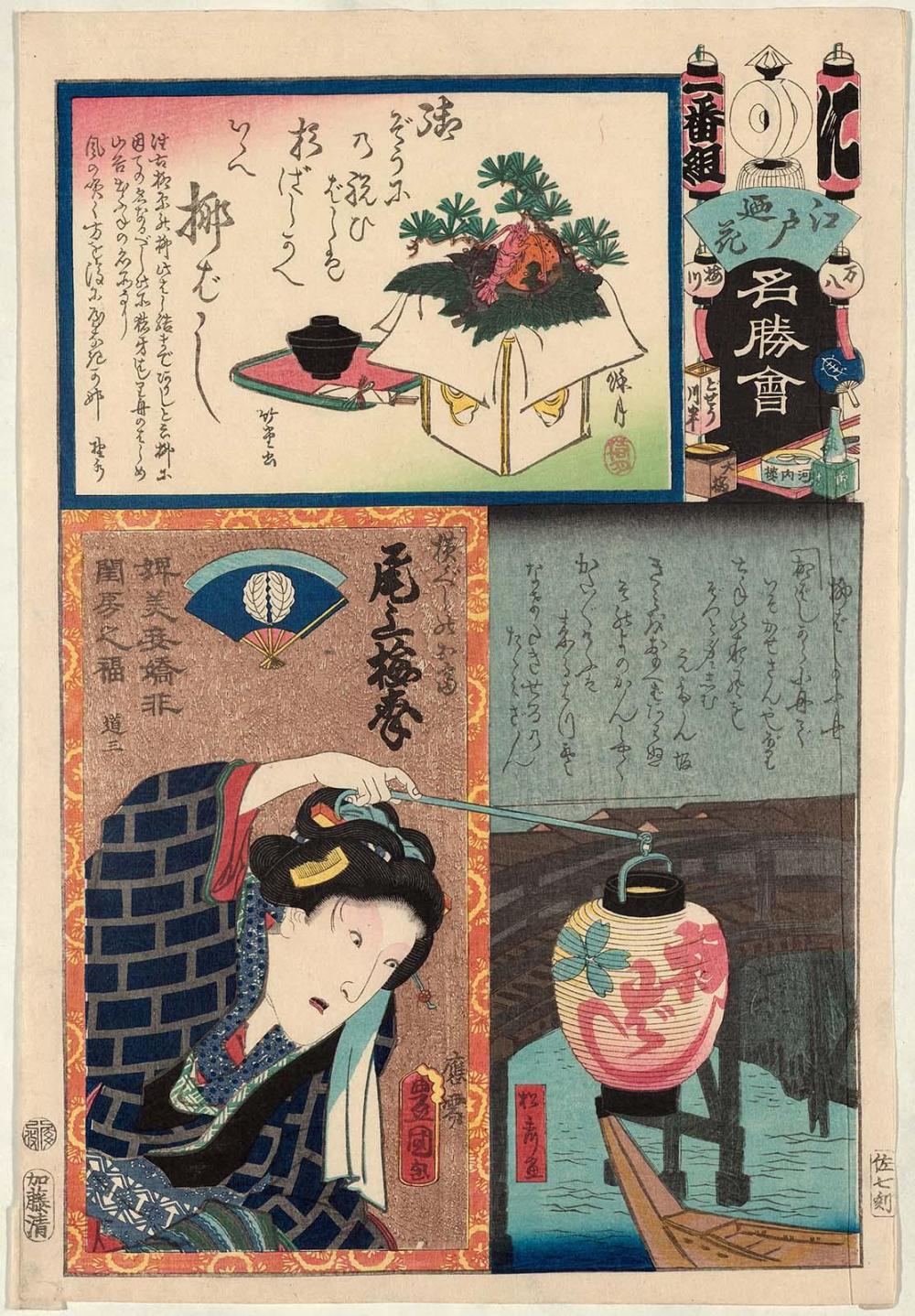Advanced Search 
「江戸廼花名勝会 に 一番組」 「柳ばし」 「横ぐしのお富 尾上梅幸」(四代目)

Ni Brigade, First Group, Yanagibashi: Actor Onoe Baikô IV as Yokogushi no Otomi, from the series Flowers of Edo and Views of Famous Places (Edo no hana meishô-e)
「江戸廼花名勝会 に 一番組」 「柳ばし」 「横ぐしのお富 尾上梅幸」(四代目)
Utagawa Kunisada I (Toyokuni III) (Japanese, 1786–1864)
Other artist: Hasegawa Settei (Japanese, 1813 – 1882)
Other artist: Chingetsu (Japanese, active 1860s)
Publisher: Katôya Iwazô (Seibei) (Japanese)
Blockcutter: Hori Sashichi (Japanese)
Other artist: Hasegawa Settei (Japanese, 1813 – 1882)
Other artist: Chingetsu (Japanese, active 1860s)
Publisher: Katôya Iwazô (Seibei) (Japanese)
Blockcutter: Hori Sashichi (Japanese)
Japanese
Edo period
1863 (Bunkyû 3), 8th month
Medium/Technique
Woodblock print (nishiki-e); ink and color on paper
Dimensions
Vertical ôban; 36.1 x 24.6 cm (14 3/16 x 9 11/16 in.)
Credit Line
William Sturgis Bigelow Collection
Accession Number11.42522
NOT ON VIEW
CollectionsAsia, Prints and Drawings
ClassificationsPrints
Catalogue Raisonné
Edo-Tokyo Museum, Edo kabuki (1995), #5-39
DescriptionMFA impressions: 11.42522, 11.45138, 11.45396.3 (creped, in album)
The term “flowers of Edo” (Edo no hana) can refer, among other things, to fires. The title panel for each print in this series shows the lanterns and identifying standard (matoi) for one of the brigades of firefighters (hikeshi) assigned to various districts. On the west side of the Sumida River were 48 brigades named for the symbols of the kana syllabary and grouped into 8 numbered groups (1 to 10, minus the bad-luck numbers 4 and 7). On the east side of the river, brigades were numbered and assigned to directional groups. Outlying districts were covered by special brigades, here designated “extra” (bangai). Each title gives the name or number of a brigade, its group, and its district, followed by the kabuki scene chosen to match it.
(見立)
The term “flowers of Edo” (Edo no hana) can refer, among other things, to fires. The title panel for each print in this series shows the lanterns and identifying standard (matoi) for one of the brigades of firefighters (hikeshi) assigned to various districts. On the west side of the Sumida River were 48 brigades named for the symbols of the kana syllabary and grouped into 8 numbered groups (1 to 10, minus the bad-luck numbers 4 and 7). On the east side of the river, brigades were numbered and assigned to directional groups. Outlying districts were covered by special brigades, here designated “extra” (bangai). Each title gives the name or number of a brigade, its group, and its district, followed by the kabuki scene chosen to match it.
(見立)
Signed
Ôju Toyokuni ga, in toshidama cartouche (bottom left); Chingetsu (top); Chikudô ga (top); Shôsai ga (bottom right)
応需 豊国画(年玉枠)、椿月、竹堂書、松斎画
応需 豊国画(年玉枠)、椿月、竹堂書、松斎画
Marks
Censor's seal: Boar 8 aratame
Blockcutter's mark: Sashichi koku
改印:亥八改
彫師:佐七刻
Blockcutter's mark: Sashichi koku
改印:亥八改
彫師:佐七刻
ProvenanceBy 1911, purchased by William Sturgis Bigelow (b. 1850–d. 1926), Boston [see note 1]; 1911, gift of Bigelow to the MFA. (Accession Date: January 19, 2005)
NOTES:
[1] Much of Bigelow's collection of Asian art was formed during his residence in Japan between 1882 and 1889, although he also made acquisitions in Europe and the United States. Bigelow deposited many of these objects at the MFA in 1890 before donating them to the Museum's collection at later dates.
NOTES:
[1] Much of Bigelow's collection of Asian art was formed during his residence in Japan between 1882 and 1889, although he also made acquisitions in Europe and the United States. Bigelow deposited many of these objects at the MFA in 1890 before donating them to the Museum's collection at later dates.
